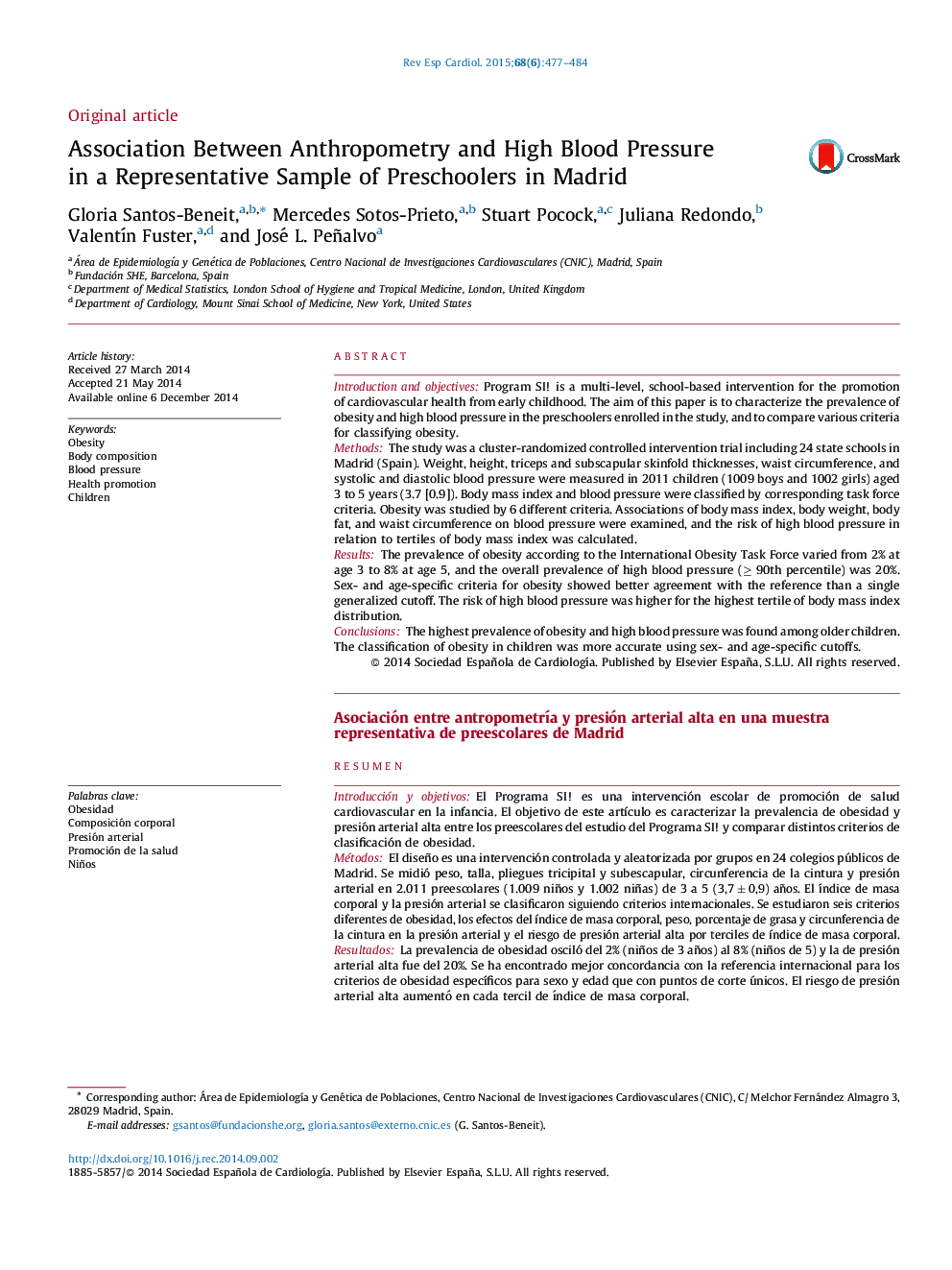| کد مقاله | کد نشریه | سال انتشار | مقاله انگلیسی | نسخه تمام متن |
|---|---|---|---|---|
| 3016399 | 1182081 | 2015 | 8 صفحه PDF | دانلود رایگان |
Introduction and objectivesProgram SI! is a multi-level, school-based intervention for the promotion of cardiovascular health from early childhood. The aim of this paper is to characterize the prevalence of obesity and high blood pressure in the preschoolers enrolled in the study, and to compare various criteria for classifying obesity.MethodsThe study was a cluster-randomized controlled intervention trial including 24 state schools in Madrid (Spain). Weight, height, triceps and subscapular skinfold thicknesses, waist circumference, and systolic and diastolic blood pressure were measured in 2011 children (1009 boys and 1002 girls) aged 3 to 5 years (3.7 [0.9]). Body mass index and blood pressure were classified by corresponding task force criteria. Obesity was studied by 6 different criteria. Associations of body mass index, body weight, body fat, and waist circumference on blood pressure were examined, and the risk of high blood pressure in relation to tertiles of body mass index was calculated.ResultsThe prevalence of obesity according to the International Obesity Task Force varied from 2% at age 3 to 8% at age 5, and the overall prevalence of high blood pressure (≥ 90th percentile) was 20%. Sex- and age-specific criteria for obesity showed better agreement with the reference than a single generalized cutoff. The risk of high blood pressure was higher for the highest tertile of body mass index distribution.ConclusionsThe highest prevalence of obesity and high blood pressure was found among older children. The classification of obesity in children was more accurate using sex- and age-specific cutoffs.
ResumenIntroducción y objetivosEl Programa SI! es una intervención escolar de promoción de salud cardiovascular en la infancia. El objetivo de este artículo es caracterizar la prevalencia de obesidad y presión arterial alta entre los preescolares del estudio del Programa SI! y comparar distintos criterios de clasificación de obesidad.MétodosEl diseño es una intervención controlada y aleatorizada por grupos en 24 colegios públicos de Madrid. Se midió peso, talla, pliegues tricipital y subescapular, circunferencia de la cintura y presión arterial en 2.011 preescolares (1.009 niños y 1.002 niñas) de 3 a 5 (3,7 ± 0,9) años. El índice de masa corporal y la presión arterial se clasificaron siguiendo criterios internacionales. Se estudiaron seis criterios diferentes de obesidad, los efectos del índice de masa corporal, peso, porcentaje de grasa y circunferencia de la cintura en la presión arterial y el riesgo de presión arterial alta por terciles de índice de masa corporal.ResultadosLa prevalencia de obesidad osciló del 2% (niños de 3 años) al 8% (niños de 5) y la de presión arterial alta fue del 20%. Se ha encontrado mejor concordancia con la referencia internacional para los criterios de obesidad específicos para sexo y edad que con puntos de corte únicos. El riesgo de presión arterial alta aumentó en cada tercil de índice de masa corporal.ConclusionesLos niños mayores mostraron la mayor prevalencia de obesidad y presión arterial alta. La clasificación de obesidad fue más precisa utilizando criterios específicos para sexo y edad.
Journal: Revista Española de Cardiología (English Edition) - Volume 68, Issue 6, June 2015, Pages 477–484
